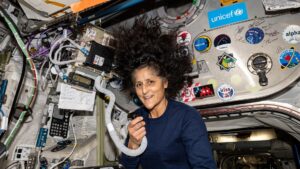Prelims Bits

Context:
Indian astronaut Shubhanshu Shukla recently communicated with students from the International Space Station (ISS) using HAM radio, marking a notable amateur radio contact between space and Earth.
About HAM Radio (Amateur Radio Service):
- A licensed, non-commercial service allowing individuals to communicate via radio frequencies for educational, recreational, and emergency purposes.
- Operates using a transceiver, frequency-appropriate antenna, and regulated transmission power.
Key Features:
- Supports voice, Morse code, text, images, and data transmission.
- Operates on frequencies between 1.8 MHz and 3000 MHz (Medium to Ultra High Frequency).
- Requires users to identify themselves with a unique call sign every 10 minutes and at the end of transmissions.
- Frequency allocation is managed by national regulators following ITU (International Telecommunication Union) guidelines.
Utility:
- Enables long-distance communication, including intercontinental and space-based links.
- Provides a low-cost, infrastructure-free method of communication during natural disasters or network outages.
- Power output is limited to prevent interference.
HAM Radio in India:
- Governed by the Indian Wireless Telegraphs (Amateur Service) Rules, 1978 under the Indian Telegraph Act.
- Licensing Authority: Wireless Planning and Coordination (WPC) Wing, Ministry of Communications.
HAM Radio in Space:
- First used in space by astronaut Owen Garriott on mission STS-9 (1983).
- Amateur Radio on the ISS (ARISS) is a joint initiative by global space agencies enabling enthusiasts to connect with astronauts in orbit.
- ISS HAM radio operates on VHF and UHF waves, requiring line-of-sight due to their inability to bend around Earth’s curvature.




